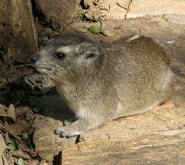 The Bush Hyrax (Heterohyrax brucei), otherwise known as the Yellow-spotted (Bush or Rock) Hyrax is a small mammal that is around 12-15 inches long (30-38 centimeters) and can weigh between 5 and 9 pounds (2.2-4 Kilograms) and has a distinctive coat of fur that is mottled with browns, yellows, and grays. It has short limbs, a black nose, short but alert ears, and large eyes. Their fur is made up of a short haired layer which protects them, and slightly longer coats which add to their colored looks. Their tail is nothing more than a small stump which is barely visible, and for a good size comparison think of an overweight bunny. The Bush Hyrax and its many subspecies are found throughout Africa, from Egypt to South Africa, and they prefer rocky terrains and mountainous areas, preferring elevations starting at sea level all the way to 13,000 feet (4,000 meters).
The Bush Hyrax (Heterohyrax brucei), otherwise known as the Yellow-spotted (Bush or Rock) Hyrax is a small mammal that is around 12-15 inches long (30-38 centimeters) and can weigh between 5 and 9 pounds (2.2-4 Kilograms) and has a distinctive coat of fur that is mottled with browns, yellows, and grays. It has short limbs, a black nose, short but alert ears, and large eyes. Their fur is made up of a short haired layer which protects them, and slightly longer coats which add to their colored looks. Their tail is nothing more than a small stump which is barely visible, and for a good size comparison think of an overweight bunny. The Bush Hyrax and its many subspecies are found throughout Africa, from Egypt to South Africa, and they prefer rocky terrains and mountainous areas, preferring elevations starting at sea level all the way to 13,000 feet (4,000 meters). The Bush Hyrax’s species name is Heterohyrax brucei, and it belongs to the Genus Heterohyrax. It is the only species in this genus – however the species itself has 25 known sub-species that have been identified. The Heterohyrax belongs to the family Procaviidae, which has two other genere other than Heterohyrax – Procavia (the Cape Hyrax) and Dendrohyrax (The Tree Hyrax).
The Bush Hyrax, like all other Hyraxes have a very primitive self temperature regulation system that seems almost reptilian. They must bask in the sun to gain heat and then huddle together at night to retain heat. It is thought that the Hyrax has evolved very little from its origins. The Bush Hyrax lives mostly in arid areas, and can survive on very little water. The breeding season is uniformly in tune with the rainy season, and gestation (pregnancy) lasts up to eight months. The young mature quickly, and between one to five months of age they are weaned from their mothers.
They eat many types of vegetation and usually prefer bitter yams, which in the past have been used by humans to create poisoned arrowheads. When thicker meatier vegetation is scarce they will turn to grasses and other lesser vegetation to feed on. Because of their highly efficient kidneys they can subsist on very little water. Due to their smaller size, they are themselves the target of many predators, such as rock pythons, leopards, birds, and even some mongoose have been so brave. However they are vicious when threatened and will counter-attack savagely, biting anything and everything on the predator to save itself from being a meal.
The Bush Hyrax behavior is to have small family groups that huddle at night, and the groups are maintained by one dominant male, whose job includes territorial defense and maintenance. Often times, if the area is large enough, the male will have several small groups of females that he will control, in different but close areas. The remaining males who survive to leave and create their own groups usually live alone until this happens. Many may live solitarily their whole lives.
Interesting Facts about the Bush Hyrax:
- The Bush Hyrax has been found in over 21 countries – and even one subspecies lives in Israel.
- In times of famine the Bush Hyrax has been a food source for humans.
- Currently the Bush Hyrax species is listed as a least-concern status by the IUCN
- Within hours after being born, a baby Bush Hyrax can already move and follow its mother.
Picture of the bush hyrax by Buecherfresser, licensed under GFDL
Keywords: yellow
The Bush hyrax, yellow-spotted rock hyrax is listed as Least Concern. Does not qualify for a more at risk category. Widespread and abundant taxa are included in this category, on the IUCN Red List of Threatened Species
Countries
Algeria, Angola, Botswana, Burundi, Congo, Democratic Republic of the, Egypt, Eritrea, Ethiopia, Kenya, Malawi, Mozambique, Rwanda, Somalia, South Africa, Sudan, Tanzania, Uganda, Zambia and ZimbabweYellow-spotted hyrax habitats
Dry savanna, Rocky areas (eg inland cliffs, mountain peaks) and SavannaSome facts about the
Bush hyrax
Adult weight : 2.457 kg (5.4054 lbs)
Female maturity :494 days
Male maturity : 494 days
Gestation : 229 days
Weaning : 91 days
Litter size : 2
Weight at birth : 0.225 kg (0.495 lbs)
Basal metabolic rate : 4 W
Body mass : 1.604 kg (3.5288 lbs)
Temperature : 36.85 °C (98.33 °F)

Custom Search